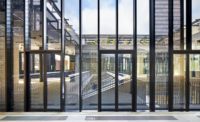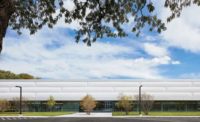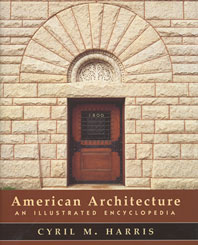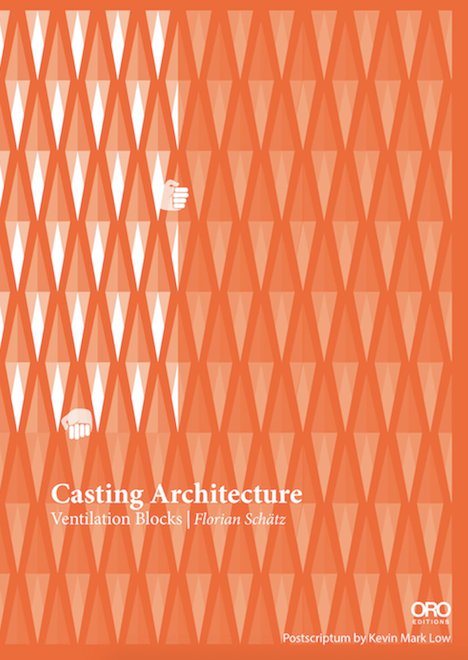By the first Sunday in October, the leaves in the Bois de Boulogne, the large, heavily forested park in Paris’s tony 16th arrondissement, begin to turn a beautiful shade of gold. It is on that day that the nearly century-old Prix de l’Arc de Triomphe is held at the Longchamp racecourse along the western edge of the park bordering the Seine. Considered Europe’s most prestigious horse race, its timing influenced the look of the track’s new grandstand, designed by Parisbased Dominique Perrault Architecture (DPA). “It’s a soft color,” says Perrault of the gilded hue of the structure, inaugurated with its first race on April 29. “It’s all about the relationship to the landscape.”
Additional Content:
Jump to credits & specifications
From the pixelated frit on the glazed balustrades to the metal mesh doors and mushroom-like sunshades that line the walkways, every part of the building is golden. But if its color was meant to blend in with nature, its form is all about the horse. “We wanted it to look like a galloping Thoroughbred,” says DPA associate and artistic director Gaëlle Lauriot-Prévost. The 115-foot-wide by 525-foot-long structure culminates in a large cantilever on the uppermost level—the metaphoric head of said Thoroughbred.
The steel-and-concrete building, which has seating capacity for about 10,000 spectators, comprises four levels—noticeably inclined toward the racecourse and slightly offset from one another for the best sightlines—giving the impression from the short direction that it, like the horses, could take off at any moment.
In the long direction, the dynamic new building—open on all sides with plein air seating, terraces, or stepped platforms—appears stretched to its limits, but it is actually considerably shorter than the pair of structures from the 1960s that it replaced. “The old stands were often empty,” says Lauriot-Prévost. While the annual Arc competition can draw up to 70,000 visitors over the course of the weekend, horseracing throughout Europe has declined in popularity, and weekly races at Longchamp host much smaller crowds. DPA’s design needed to be flexible enough to adjust to such fluctuations in numbers, and also to accommodate concerts and other cultural and sporting events—which this summer included Lollapalooza—as well as smaller private affairs, to add year-round value to the project outside of racing season.
Parallel to the grandstand, a substantial walkway that DPA calls la planche extends nearly twice the length of the building itself and acts as an elevated viewing platform in front of a large green. From that vantage point, one can see the famous flat track, which was slightly altered in the new building project. For more popular races and events, that large green accommodates temporary seating, as does the landmarked 1921 grandstand—used only on very rare occasions—on the opposite side of DPA’s building. (A third building next to the historic structure houses offices and services.)
The precast-concrete walkway, which becomes U-shaped around the cascading main entrance, is an integral part of the design. The grandstand and racecourse flank the walkway on one side. On the other, a series of spaces—from the renovated and enlarged stables to the beautifully landscaped paddock area where horses are shown off before and after races—border it. At the center of it all, la planche is really a grand boulevard, a promenade to see and be seen. Beneath it is an enfilade of flexible rooms and spaces for storage, meeting, and mechanicals, as well as a large bistro and the all-important jockeys’ weighing room. On the walkway itself, those square-topped, mushroom-like umbrellas, as DPA calls them, either 15- or 18-feet tall, add a lively rhythm to the procession, and provide shelter from the sun, if not the rain.
Interiors have been kept simple, punctuated here and there with custom light fixtures DPA designed, including a grand chandelier in the presidential lounge. A rhythmic pattern of evenly spaced rows of discs mounted to ceilings incorporates lighting, speakers, and—critical for placing smartphone bets—WiFi access points. (Betting stations are located at various spots within corridors and in a first-floor lounge.)
DPA, inspired by the nature of the activity on this 140-acre site and its incomparable setting within the stately Bois de Boulogne, kept the focus on the outdoors, wisely making the grandstand itself as porous as possible—a significant change from the previous incarnation. While there are elegantly appointed VIP suites on the upper levels, the more public areas are, in this case, more desirable—exposed to race-day activity and sounds on either side, with both sunlight and breezes flowing through. A rooftop restaurant and terrace offer breathtaking views over the park and to the jumble of towers of La Défense to the west, and the center of Paris to the east. The wide open building, despite being gilded and set in the poshest part of Paris, welcomes all visitors, including those unfamiliar with the elite sport and its hallowed traditions, to enjoy a day at the races.
CreditsArchitect: Dominique Perrault Architecture
Engineering: Tractebel Engineering (structural)
Consultants: Agence Ter (landscape); Terrell (facade); J-P Lamoureux (lighting, acoustics)
General contractor: Bouygues Bâtiment-Ile-de-France |
SpecificationsMetal structure Bysteel
Metal roof Riverclack
Glazing Saint-Gobain
Metal mesh GKD
Wood panels Topakustik
Elevators Otis |















